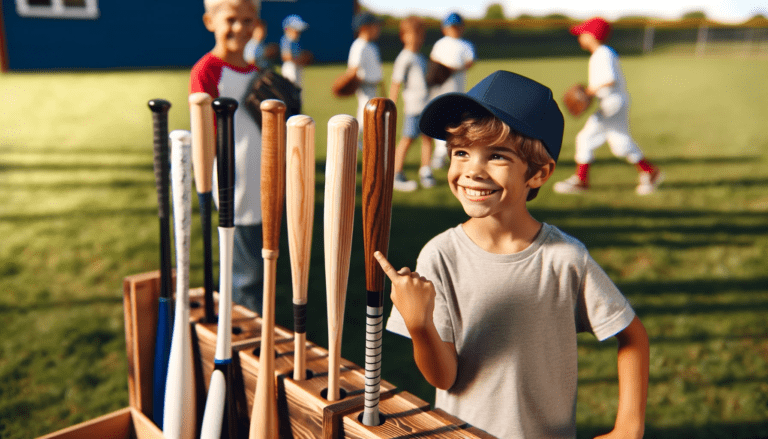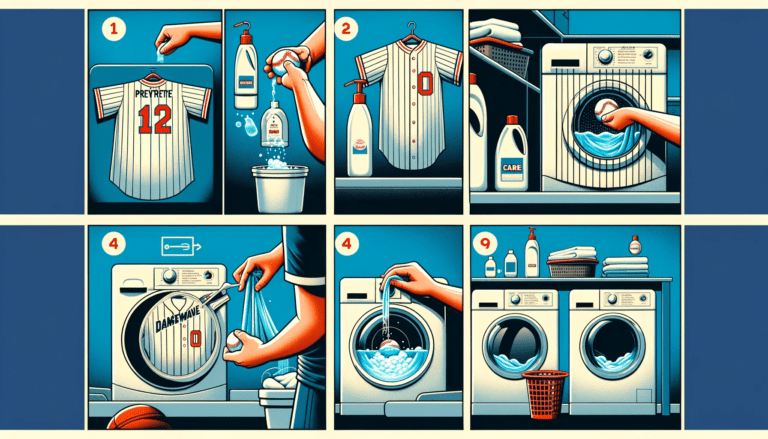How to Tell If a Baseball Bat is Dead?
How to Tell If a Baseball Bat is Dead? There are some simple ways to check if your bat still has life left in it. Look for hairline cracks, listen for a duller sound on hits, and pay attention if it feels lighter than normal. With these easy tips, you can decide if it’s time to retire your old faithful bat.
In this article, we’ll explore the telltale signs that indicate whether your bat is past its prime. By following these simple steps, you’ll be able to determine if it’s time to retire your trusty companion and invest in a new one.
So, if you’ve been wondering whether your bat still has some juice left in it or if it’s time for an upgrade, keep reading to find out.
Key Takeaways
- Physical signs of wear and personal hitting habits, such as not using batting gloves and high swing volume, can significantly reduce a bat’s lifespan.
- Swing mechanics and bat material play a pivotal role in bat performance, with aggressive swings and poor material choices leading to faster decline.
- The psychological state of a batter, including confidence levels and mental strain, can influence batting performance and potentially affect bat condition.
- Statistical analysis, including metrics like hard-hit rate, launch angle, and exit velocity, can provide objective indicators of a bat losing its efficacy.
- Proper maintenance and timely replacement of a baseball bat, coupled with adjustments in swing mechanics, can help revitalize batting experience.
Understanding Bat Performance Decline

Identifying Signs of Wear and Tear
A baseball bat’s lifespan is a testament to the countless pitches it has encountered. Over time, visible signs of wear and tear on alloy bats can indicate a decline in performance.
These signs include cracks, dents, or a splintering barrel, which can drastically affect the bat’s integrity and your ability to hit consistently.
When inspecting your bat, pay close attention to the following:
- The condition of the grip: Is it losing its tackiness?
- Any unusual sounds: A change in the bat’s acoustic signature can suggest internal damage.
- The smoothness of the barrel: Look for any rough spots or indentations.
Regular assessment of these factors can help you determine when it’s time to consider a replacement, ensuring that your equipment doesn’t hinder your performance at the plate.
The Impact of Seasonal Breaks on Bat Longevity
Seasonal breaks can have a profound effect on the longevity of a baseball bat. During the off-season, a lack of regular use can lead to the softball bat itself‘s materials settling or warping, especially in composite bats known for their ‘trampoline effect‘.
This effect, crucial for enhancing batted-ball speed, may diminish over time without proper care.
For players who swing a bat extensively during the season, the sudden halt in activity can cause an adjustment period when picking the bat back up.
The transition from high-frequency use to a period of rest can result in a need for the bat to be ‘broken in’ again, as the materials have had time to rest and potentially change their performance characteristics.
- Regular maintenance during breaks can help preserve bat performance.
- Gradually reintroducing the bat to hitting can mitigate the effects of a long layoff.
- Storing the bat in a controlled environment can prevent warping and material degradation.
How Personal Hitting Habits Affect Bat Life
The longevity of a baseball bat can be significantly influenced by a player’s hitting habits. Frequent practice without proper care can lead to premature wear.
For instance, a player who doesn’t use batting gloves may experience increased friction on the bat’s handle, causing it to deteriorate faster.
Additionally, aggressive swinging, especially when trying to hit home runs, can strain the bat more than a controlled, contact-focused approach.
Understanding the nuances of your hitting style is crucial. A player who swings excessively hard may not only miss more pitches but also cause unnecessary stress on the bat.
Conversely, a player who takes a break from hitting may need to ease back into practice to prevent sudden damage to the bat from resumed activity.
Here are some factors to consider:
- The frequency and intensity of your swings
- Whether you use batting gloves or other protective gear
- Your approach to hitting, whether it’s power-focused or contact-focused
- The type of pitches you struggle with, as this can affect your swing decisions
Read Also: What Does Pine Tar Do in Baseball Bat
Analyzing Swing Mechanics and Bat Interaction
The Correlation Between Swing Decisions and Bat Efficacy
The effectiveness of a baseball bat is closely tied to the swing decisions a batter makes.
Aggressive swings aimed at hitting home runs can lead to an increased flyball rate and a higher chance of missing the ball altogether.
This approach often results in a rise in swinging strike rate (SwStr%) and a decrease in contact quality, as seen with players like Bellinger who exhibit a significant jump in flyball rate and a decline in Ideal Contact Rate (ICR).
When batters opt for early swings in the count, they may encounter fewer two-strike counts but also risk making less successful contact. This strategy can backfire, especially if the batter’s power is overestimated.
A meticulous analysis of swing decisions can reveal patterns, such as a tendency to pull the ball more or a susceptibility to certain pitch types like curveballs, which can drastically affect batting outcomes.
To optimize bat performance, hitters should consider:
- The count and pitch type before deciding to swing.
- The trade-off between power and contact quality.
- Adjusting their aggressiveness based on their hitting strengths and weaknesses.
Evaluating Changes in Swing Aggressiveness
As players strive to enhance their performance, a shift towards more aggressive swing decisions can be observed.
This often manifests as an increased flyball rate and a tendency to swing at pitches early in the count. However, such aggressiveness may not always yield the desired results.
For instance, a player might experience a rise in their swinging strike rate (SwStr%) and a higher rate of pulling the ball, which could indicate overzealousness at the plate.
To properly evaluate these changes, consider the following:
- Assess whether there is an increase in the frequency of swings and misses.
- Analyze the types of pitches being targeted and the resulting ball trajectory.
- Monitor the hard-hit rate and average launch angle to gauge the quality of contact.
Understanding the nuances of these metrics can reveal whether a player is effectively harnessing their aggressiveness or if adjustments are needed to avoid detrimental effects on their batting performance.
The Role of Bat Material in Swing Dynamics
The material of a baseball bat can significantly influence a player’s swing dynamics. Aluminum bats, for example, are known for their lightweight and durable properties, allowing for quicker swings and potentially greater bat speed.
On the other hand, wooden bats, which are heavier than metal, may contribute to a more controlled swing, emphasizing precision over speed.
- Aluminum bats: Enhance bat speed and are less prone to breakage.
- Wooden bats: Offer a traditional feel and can improve swing control.
The choice of bat material can also affect the bat’s sweet spot, the area where contact with the ball will result in the maximum transfer of energy.
A bat’s mass and the position of its center of gravity are crucial factors that affect both linear and angular acceleration during the swing. These features must be tailored to the individual player to optimize performance.
Ultimately, the interaction between the bat material and a player’s swing mechanics can have a profound impact on their hitting success.
Read Also: Why Do Baseball Players Use Wooden Bats
The Psychological Aspect of Batting
The Influence of Confidence on Batting Performance
Confidence at the plate is a critical component of a batter’s success. A confident batter is more likely to make decisive swings and capitalize on pitch opportunities. This mental state can be cultivated through various means:
- Mental preparation before stepping up to bat
- Maintaining focus on the current at-bat, rather than past failures or successes
- Consistent practice to reinforce muscle memory and reduce hesitation
When a player’s confidence wavers, it often manifests in their performance. Hesitant swings, second-guessing pitch selection, and a general decline in aggressiveness can all be signs that a batter’s self-assurance is faltering.
Players need to recognize these symptoms and address them promptly, as confidence can be as influential as physical skill in batting outcomes.
Coping with the Mental Strain of a Slump
The mental strain of a slump in baseball can be as debilitating as a physical injury. Players often find themselves in a cycle of stress and self-doubt that can exacerbate the issue, leading to a prolonged dip in performance.
It’s crucial to address this mental strain with the same seriousness as one would a batting technique flaw or a physical ailment.
To navigate through this challenging period, consider the following steps:
- Acknowledge the slump without judgment, understanding that it’s a natural part of the sport.
- Seek support from coaches, teammates, or a sports psychologist who can provide strategies to rebuild confidence.
- Implement mental exercises such as visualization and positive self-talk to reinforce a success-oriented mindset.
Remember, a slump is temporary, and with the right mental approach, you can emerge stronger and more resilient.
It’s about finding balance, whether that means taking a step back to rest or pushing forward with renewed focus.
By staying committed to the light of truth and transparency in your efforts, you can lift the weight of the slump and return to peak performance.
Celebratory Practices and Their Effect on Bat Condition
Baseball is as much about tradition and emotion as it is about skill and strategy. Celebratory practices, while boosting team morale, can sometimes be detrimental to a bat’s condition.
For instance, players often engage in exuberant celebrations that involve the bat, such as bat flips or emphatic spikes into the ground after a successful hit.
These actions and bat sound, although crowd-pleasing, can cause unseen damage to the bat’s structure over time.
- Animated celebrations, like Josh Naylor’s helmet smash and bat spike, are a testament to the game’s passion but may compromise the bat’s integrity.
- The repetitive impact from such celebrations can lead to micro-fractures or the loosening of the bat’s grip.
To preserve the bat’s lifespan, players might consider alternative celebration methods that do not involve the bat.
This could include high-fives, team huddles, or other non-impactful expressions of success. By doing so, players ensure that their trusted equipment remains in top condition for the moments that count.
Read Also: How to Hold a Baseball Bat Right Handed
Statistical Indicators of a Bat Losing Its Edge
Analyzing Performance Metrics: From Hard-Hit Rate to SwStr%
In the quest to understand when a bat may be losing its effectiveness, certain performance metrics stand out as critical indicators.
Advanced statistics such as exit velocity, hard-hit rate, and barrel percentage provide a quantifiable measure of a player’s potential and the bat’s contribution to their success.
Players with high marks in these areas are often seen as having a competitive edge.
- Exit velocity reflects the speed at which the ball leaves the bat, indicating the bat’s ability to transfer energy to the ball.
- Hard-hit rate measures the frequency of balls hit with significant force, suggesting consistent bat performance.
- Barrel percentage is the rate at which a player makes optimal contact, a direct reflection of both skill and bat integrity.
A decline in these metrics can signal a bat’s diminishing return on a player’s swing.
For instance, an increase in SwStr% (swinging strike percentage) or a decrease in Ideal Contact Rate (ICR) may point to a bat that no longer performs at its peak.
Analyzing these statistics over time can help players make informed decisions about when to consider replacing their bat.
The Significance of Launch Angle and Exit Velocity
In the quest to perfect the art of hitting, launch angle and exit velocity have emerged as critical components.
Launch angle refers to the angle at which the ball leaves the bat, influencing whether it’s a ground ball, line drive, or fly ball.
Exit velocity, on the other hand, is the speed at which the ball leaves the bat, directly correlating with the potential distance the ball can travel.
Understanding these metrics can provide insight into a batter’s performance and areas for improvement.
For instance:
- A higher launch angle may increase the chances of hitting home runs, but also the risk of pop-ups.
- Optimal exit velocity ensures that even well-hit balls aren’t easily caught by fielders.
Analyzing these factors can help players adjust their swing to maximize their hitting potential.
However, it’s essential to strike a balance, as an overemphasis on one aspect can lead to issues such as increased swing and miss rates or a tendency to pull the ball on the ground.
Interpreting In-Season vs. Off-Season Batting Stats
When analyzing batting stats, it’s crucial to distinguish between in-season and off-season performance.
In-season stats often reflect a player’s current form and note any adjustments they’ve made, while off-season stats can indicate how well a player has maintained or improved their skills during the break.
- In-season stats can reveal trends such as a rise in strikeout rates or a decrease in contact rates, suggesting a potential decline in bat performance.
- Off-season stats provide insight into a player’s discipline and work ethic, as improvements in walk rates or chase rates indicate focused training.
Comparing these stats helps identify if a player is compensating for a loss in bat ‘life’ by altering their swing decisions, such as swinging more aggressively or changing their approach to hitting.
This comparison can also highlight if a player is experiencing a temporary slump or if their bat truly has lost its edge.
Revitalizing Your Batting Experience
Choosing the Right Time to Replace Your Bat
Determining the optimal moment to replace your baseball bat is crucial for maintaining peak performance at the plate.
Listen to your bat; it often tells its own story through performance and feel. If you notice a significant drop in the pop or hear a change in the sound it makes upon contact, it might be signaling that it’s time for a new companion.
Consider these factors when deciding to replace your bat:
- The age and condition of the bat, including any cracks, dents, or severe wear.
- Your personal hitting statistics, such as a noticeable decline in batting average or power numbers.
- How the bat feels during swings, especially if it starts to feel heavier or unbalanced.
Ultimately, the decision to replace a bat should be based on a combination of these elements. Trust your instincts and the feedback your bat provides to make the best choice for your game.
Maintenance Tips to Extend Bat Life
Proper maintenance of your baseball bat is crucial for ensuring its longevity and performance.
Regular cleaning is essential; remove dirt and debris after each use to prevent buildup that can affect the bat’s surface and balance.
Use a soft cloth and mild soap for composite bat, while wood bats may benefit from light sanding to maintain a smooth surface.
Storage conditions also play a significant role in preserving your bat. Avoid extreme temperatures and moisture by storing your dead bat up in a cool, dry place.
A bat sleeve, like the Markwort Tuff Sleeve Bat Protection, can provide additional safeguarding against dents and scratches, ensuring your bat remains in top condition without affecting ball flight.
Lastly, inspect your bat regularly for signs of damage such as cracks, dents, or severe scuffs.
Early detection of these issues can prevent further deterioration and potentially extend the bat’s usable life.
By adhering to these maintenance tips, you can help your bat withstand the rigors of the game for as long as possible.
Adjusting Your Swing to Compensate for Bat Wear
As your bat begins to show signs of wear, it’s crucial to adjust your swing to maintain performance.
This doesn’t mean overhauling your technique but making subtle changes to compensate for the bat’s altered characteristics.
- Start by focusing on bat control rather than power. A worn bat may not provide the same pop, so ensuring solid contact is key.
- Consider shortening your swing. This can help you react quicker to pitches and maintain a higher contact rate.
- Pay attention to the weight distribution in your stance. As the bat’s weight may shift over time, rebalancing your stance can help you stay agile.
By being mindful of these adjustments, you can extend the life of your bat and sustain your hitting effectiveness. It’s about working with what you have and optimizing your approach at the plate.
Conclusion
In baseball, the bat is your partner, and knowing when it’s time to part ways can be as nuanced as the game itself.
Throughout this article, we’ve explored the telltale signs that your bat may have lost its life, from the subtle cues in your swing to the more overt indicators of wear and performance decline.
Whether you’re a seasoned player who’s swung a bat thousands of times or a newcomer to the diamond, understanding these signs is crucial for maintaining your edge.
Remember, a bat isn’t just a piece of equipment—it’s an extension of your skill, passion, and dedication to the sport.
So, when the time comes to retire your trusted ally, do so with respect and anticipation for the new possibilities that await with a fresh bat in hand.
Frequently Asked Questions
How can I tell if my baseball bat is starting to wear out?
Signs of bat wear include visible dents, cracks, or chips, a decrease in the bat’s pop or responsiveness, and an increase in vibrations felt after contact. Consistent friction and rubbing from use without batting gloves can also accelerate wear.
Does taking a break from hitting during the off-season affect my bat’s performance?
Seasonal breaks can help preserve your bat’s life by reducing continuous stress, but it’s important to ease back into hitting to avoid damaging the wood bat, or causing blisters on your hands.
What swing decisions could be affecting my bat’s efficacy?
Swing decisions such as trying to drive the ball out of the park early in the count, being overly aggressive, or swinging at pitches that are difficult to hit consistently can lead to decreased bat performance and increased wear.
How does my psychological state influence batting performance?
Confidence can significantly affect your batting performance. A positive mindset can lead to better focus and decision-making, while a slump can cause mental strain and potentially affect how you use and care for your bat.
What statistical indicators suggest my bat might be losing its edge?
Declines in hard-hit rate, exit velocity, and launch angle can indicate your bat is losing its edge. An increase in strikeout rate (K%) or swinging strike rate (SwStr%) might also suggest it’s time to assess your bat’s condition.
When should I consider replacing my bat, and how can I extend its life?
Consider replacing your bat if you notice a consistent decline in performance, visible damage, or if it no longer meets your playing standards. Extend its life with proper maintenance, like regular cleaning, storing it in a controlled environment, and using it appropriately.







